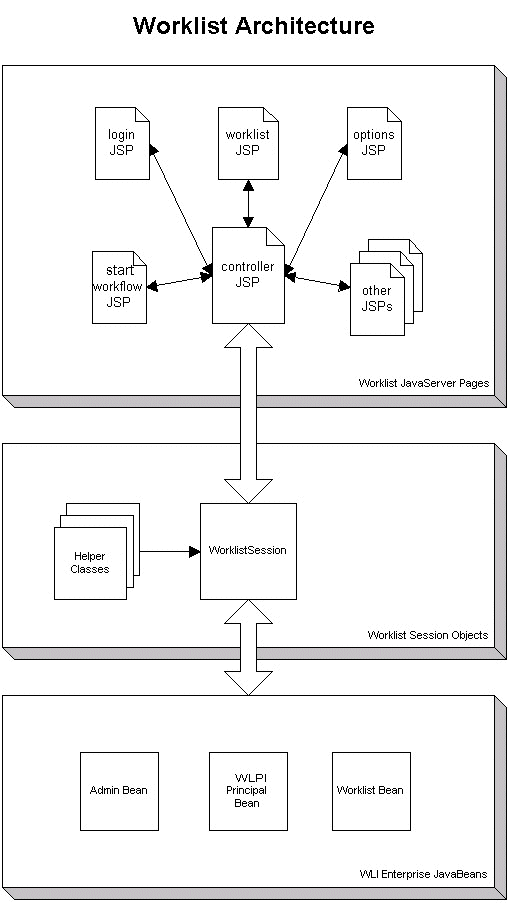

| Download Docs | Site Map | Glossary | |
|
|
|||
| bea.com | products | dev2dev | support | askBEA |
 |
 |
|
|||||||
| e-docs > WebLogic Platform > WebLogic Integration > BPM Topics > Using the JSP Worklist > JSP Developer Customizations |
|
Using the JSP Worklist
|
JSP Developer Customizations
Note: The JSP Worklist replaces the deprecated Worklist Swing client.
To allow customizing the new JSP Worklist, the source code for all pages and classes are included in this release. The following sections explain how to customize the JSP Worklist for your deployment:
Architecture
The JSP Worklist is a Web application composed of JavaServer Pages (JSPs) and Java classes packaged in a Web Application Archive (WAR) file. There are three tiers in the overall architecture: Worklist JSPs, a Worklist session object, and WebLogic Integration Enterprise JavaBeans. Figure 5-1 shows the architecture.
Figure 5-1 JSP Worklist Architecture
The Worklist JSPs instantiates and uses one WorklistSession object. This session object then connects and uses the Admin, WLPI Principal, and Worklist WLI Enterprise JavaBeans (EJBs). The Worklist session object is designed to be the interface between the JSPs and the WebLogic Integration Server. The WebLogic Integration API is referenced within this session object and isolates the JSPs from the complex WebLogic Integration coding. JavaServer Pages The JSP Worklist is made up of several JSPs that the end-user views and navigates. The worklist and controller pages are the most important pages. The worklist page (worklist.jsp) is the primary page. This page displays the user and role task lists. From this page, the end-user can perform various task operations or select other related functions. A controller page (controller.jsp) handles page navigation and processing between all JSP Worklist pages. As the user moves from page to page, the controller page is called and processes the user response. Specifically, the controller page determines the context of the user response, processes it, and then redirects the user to the appropriate page. WorklistSession Class The WorklistSession class (com.bea.wli.jsp.worklist.WorklistSession) acts as an interface between the Worklist JSPs and the WebLogic Integration EJBs. The JSPs make requests from the WorklistSession object, which then calls the WebLogic Integration EJBs. Any returned information is sent back to the WorklistSession object. The WorklistSession object may then convert and return the information in a usable format back to the requesting JSP. The WorklistSession object also persists session state as the user navigates through the pages.
Customizing the JSP Worklist
This section describes how to customize the Worklist, rebuild it, and deploy it with your specifications.
End-User Custom Options
The end-user can customize the following options in Worklist:
These user settings are saved to a cookie so that the changes can be restored in the next session.
Customizing Skins
Worklist uses cascading style sheets (CSS) to control the look and feel for all pages. Four skins are included in this release that the end-user can use. Each skin is contained in its own directory and named after its skin name. You can create and add new skins by using one of the shipped skins as a template. These files are located in the following directory:
BEA_HOME\weblogic700\integration\src\jsp\worklist\skins
In the preceding line, BEA_HOME represents the WebLogic Platform home.
To create a new skin, take the following steps:
Customizing Worklist Page Content
The JSP component is the presentation layer of the JSP Worklist. In addition to customizing the skins to change the look and feel, you can modify the JSPs to change the layout of the page content.
The JSPs are written primarily in HTML using cascading style sheets. JSP scriplets are kept to a minimum because most of the processing logic is done in the WorklistSession class. This means a Web designer can focus on the presentation layer in the JSP files, while a Java developer can maintain the Java code within the WorklistSession and helper classes.
Extending Worklist
You are free to customize the Worklist JSPs to meet your requirements. The JSP Worklist architecture is a suggested model that separates the JSP presentation layer from the processing layers. The WorklistSession class is a processing layer that simplifies many of the WebLogic Integration EJB API calls.
To extend the Worklist functionality, modify the WorklistSession class or create other session classes to perform your own business functions. The Worklist JSPs can then be modified to make your new functionality available to the user.
Note: Future releases of WebLogic Integration will implement the JSP Worklist by using JSP custom tag libraries.
Rebuilding the JSP Worklist
An Ant build script is included for rebuilding the JSP Worklist Web application worklist.war file. All the JSP Worklist source code is included in the WebLogic Integration 7.0 SP2 release so you can perform a complete build,.
To rebuild the application, take the following steps:
BEA_HOME\weblogic700\integration\src\jsp\worklist\project
Note: The rebuild procedure will overwrite the existing worklist.war file in the integration\lib directory.
Migrating to the JSP Worklist
The JSP Worklist web application is configured and deployed by default in WebLogic Integration 7.0 SP2. It is not a stand-alone Web application because it requires class files from other EJBComponents within the WebLogic Integration application.
To use the JSP Worklist for previously created WebLogic Integration 7.0 domains, you must update your domain config.xml file to properly deploy the worklist.war file. In your domain config.xml, add the following information inside the WebLogic Integration <Application> tag:
<WebAppComponent Name="WLI-BPM JSP Worklist" Targets="<TARGET_NAME>" URI="worklist.war"/>
The value for <TARGET_NAME> should be either the server name or cluster name depending on your configuration.
The new worklist.war file is located in the BEA_HOME\weblogic700\integration\lib directory, where BEA_HOME represents the WebLogic Platform home.
Note: For more information about config.xml, see "WebLogic Integration Sample Configuration File" in Starting, Stopping, and Customizing BEA WebLogic Integration.

|

|

|